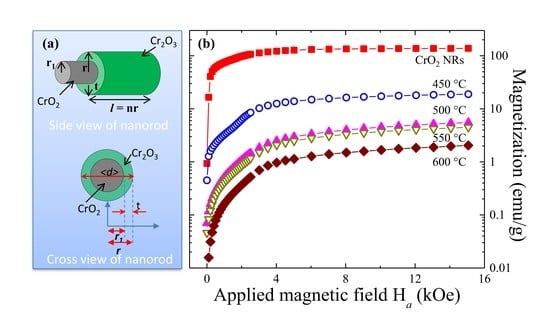Short-Range Correlated Magnetic Core-Shell CrO2/Cr2O3 Nanorods: Experimental Observations and Theoretical Considerations
Abstract
:1. Introduction
2. Synthesis of CrO2/Cr2O3 Nanostructures
3. Results and Discussion
3.1. X-ray Diffraction Analysis
3.2. Morphological and Structural Analysis
3.3. Determination of Core-Diameter and Shell-Thickness from the Saturated Magnetization
3.4. Temperature Dependence of Thermoremanent Magnetization (TRM)
3.5. Finite Size Scaling Method
4. Conclusions
Supplementary Materials
Author Contributions
Acknowledgments
Conflicts of Interest
References
- Velasquez, E.A.; Lopez-Moreno, S.; Mazo-Zuluaga, J.; Mejia-Lopez, J. Fe/Ni core-shell nanowires and nanorods: A combined first-principles and atomistic simulation study. Phys. Chem. Chem. Phys. 2017, 19, 16267–16275. [Google Scholar] [CrossRef] [PubMed]
- Gandhi, K.; Chaudhary, R.P.; Mohapatra, J.; Koymen, A.R.; Liu, J.P. Giant exchange bias and its angular dependence in Co/CoO core-shell nanowire assemblies. Phys. Lett. A 2017, 381, 2092–2096. [Google Scholar] [CrossRef]
- Salazar-Alvarez, G.; Geshev, J.; Agramunt-Puig, S.; Navau, C.; Sanchez, A.; Sort, J.; Nogués, J. Tunable High-Field Magnetization in Strongly Exchange-Coupled Freestanding Co/CoO Core-Shell Coaxial Nanowires. ACS Appl. Mater. Interface 2016, 8, 22477–22483. [Google Scholar] [CrossRef] [PubMed]
- Liébana-Viñas, S.; Wiedwald, U.; Elsukova, A.; Perl, J.; Zingsem, B.; Semisalova, A.S.; Salgueiriño, V.; Spasova, M.; Farle, M. Structure-Correlated Exchange Anisotropy in Oxidized Co80Ni20 Nanorods. Chem. Mater. 2015, 27, 4015–4022. [Google Scholar] [CrossRef]
- Javed, K.; Li, W.J.; Ali, S.S.; Shi, D.W.; Khan, U.; Riaz, S.; Han, X.F. Enhanced exchange bias and improved ferromagnetic properties in Permalloy-BiFe0.95Co0.05O3 core-shell nanostructures. Sci. Rep. 2015, 5, 18203. [Google Scholar] [CrossRef] [PubMed]
- Singh, G.P.; Ram, S. Optical and electron paramagnetic resonance properties of native Cr2O3 surface over CrO2. J. Magn. Magn. Mater. 2010, 322, 1484–1487. [Google Scholar] [CrossRef]
- Zhao, Q.; Wen, G.; Liu, Z.; Yuan, J.; Li, D.; Zou, G.; Zheng, R.; Ringer, S.P.; Mao, H.-K. High-density, vertically aligned crystalline CrO2 nanorod arrays derived from chemical vapor deposition assisted by AAO templates. Chem. Commun. 2009, 14, 3949–3951. [Google Scholar] [CrossRef] [PubMed]
- Dho, J.; Ki, S.; Gubkin, A.F.; Park, J.M.S.; Sherstobitova, E.A. A neutron diffraction study of half-metallic ferromagnet nanorods. Solid State Commun. 2010, 150, 86–90. [Google Scholar] [CrossRef]
- Schwarz, K. CrO2 predicted as a half-metallic ferromagnet. J. Phys. F Met. Phys. 1986, 16, L211. [Google Scholar] [CrossRef]
- Coey, R.; Skomski, J.M.D. Permanent Magnetism; Taylor & Francis: New York, NY, USA, 1999. [Google Scholar]
- Skomski, R. Simple Models of Magnetism; Oxford University Press: Oxford, UK, 2008. [Google Scholar]
- Solovyev, I.V.; Kashin, I.V.; Mazurenko, V.V. Mechanisms and origins of half-metallic ferromagnetism in CrO2. Phys. Rev. B 2015, 92, 144407. [Google Scholar] [CrossRef]
- Coey, J.M.D.; Berkowitz, A.E.; Balcells, L.; Putris, F.F.; Barry, A. Magnetoresistance of Chromium Dioxide Powder Compacts. Phys. Rev. Lett. 1998, 80, 3815–3818. [Google Scholar] [CrossRef]
- Dai, J.; Tang, J. Junction-like magnetoresistance of intergranular tunneling in field-aligned chromium dioxide powders. Phys. Rev. B 2001, 63, 054434. [Google Scholar] [CrossRef]
- Shim, J.H.; Lee, S.; Dho, J.; Kim, D.-H. Coexistence of Two Different Cr Ions by Self-Doping in Half-Metallic CrO2 Nanorods. Phys. Rev. Lett. 2007, 99, 057209. [Google Scholar] [CrossRef] [PubMed]
- Hwang, H.Y.; Cheong, S.W. Enhanced Intergrain Tunneling Magnetoresistance in Half-Metallic CrO2 Films. Science 1997, 278, 1607–1609. [Google Scholar] [CrossRef] [PubMed]
- Biswas, S.; Singh, G.P.; Ram, S.; Fecht, H.J. Surface stabilized GMR nanorods of silver coated CrO2 synthesized via a polymer complex at ambient pressure. J. Magn. Magn. Mater. 2013, 339, 175–181. [Google Scholar] [CrossRef]
- Anwar, M.S.; Aarts, J. Anomalous transport in half-metallic ferromagnetic CrO2. Phys. Rev. B 2013, 88, 085123. [Google Scholar] [CrossRef]
- Corliss, L.M.; Hastings, J.M.; Nathans, R.; Shirane, G. Magnetic Structure of Cr2O3. J. Appl. Phys. 1965, 36, 1099–1100. [Google Scholar] [CrossRef]
- Brown, P.J.; Forsyth, J.B.; Lelièvre-Berna, E.; Tasset, F. Determination of the magnetization distribution in Cr2O3 using spherical neutron polarimetry. J. Phys. Condens. Matter 2002, 14, 1957. [Google Scholar] [CrossRef]
- Makhlouf, S.A.; Bakr, Z.H.; Al-Attar, H.; Moustafa, M.S. Structural, morphological and electrical properties of Cr2O3 nanoparticles. Mater. Sci. Eng. B 2013, 178, 337–343. [Google Scholar] [CrossRef]
- Sahoo, S.; Binek, C. Piezomagnetism in epitaxial Cr2O3 thin films and spintronic applications. Philos. Mag. Lett. 2007, 87, 259–268. [Google Scholar] [CrossRef]
- McGuire, T.R.; Scott, E.J.; Grannis, F.H. Antiferromagnetism in a Cr2O3 Crystal. Phys. Rev. 1956, 102, 1000–1003. [Google Scholar] [CrossRef]
- Das, P.; Bajpai, A.; Ohno, Y.; Ohno, H.; Müller, J. On the influence of nanometer-thin antiferromagnetic surface layer on ferromagnetic CrO2. J. Appl. Phys. 2012, 112, 053921. [Google Scholar] [CrossRef]
- Wang, Z.; Xi, L.; Yang, Y.; Li, Y.; Han, X.; Zuo, Y.; Wang, J. Spin-dependent Transport Properties of CrO2 Micro Rod. Nano-Micro Lett. 2014, 6, 365–371. [Google Scholar] [CrossRef]
- Bajpai, A.; Borisov, P.; Gorantla, S.; Klingeler, R.; Thomas, J.; Gemming, T.; Kleemann, W.; Büchner, B. Interface-driven magnetoelectric effects in granular CrO2. Eur. Phys. Lett. 2010, 91, 17006. [Google Scholar] [CrossRef]
- Bajpai, A.; Klingeler, R.; Wizent, N.; Nigam, A.K.; Cheong, S.W.; Büchner, B. Unusual field dependence of remanent magnetization in granular CrO2: The possible relevance of piezomagnetism. J. Phys. Condens. Matter 2010, 22, 096005. [Google Scholar] [CrossRef] [PubMed]
- Gandhi, A.C.; Wu, S.Y. Unidirectional anisotropy mediated giant memory effect in antiferromagnetic Cr2O3 nanorods. RSC Adv. 2017, 7, 25512–25518. [Google Scholar] [CrossRef]
- Rietveld, H. A profile refinement method for nuclear and magnetic structures. J. Appl. Crystallogr. 1969, 2, 65–71. [Google Scholar] [CrossRef]
- Von Dreele, R.B.; Larson, A.C. General Structure Analysis System (GSAS); Los Alamos National Laboratory Report LAUR 86-748; Los Alamos National Laboratory: Los Alamos, NM, USA, 2000; p. 221. [Google Scholar]
- Xu, X.N.; Wolfus, Y.; Shaulov, A.; Yeshurun, Y.; Felner, I.; Nowik, I.; Koltypin, Y.; Gedanken, A. Annealing study of Fe2O3 nanoparticles: Magnetic size effects and phase transformations. J. Appl. Phys. 2002, 91, 4611–4616. [Google Scholar] [CrossRef]
- Gandhi, A.C.; Cheng, H.-Y.; Chang, Y.-M.; Lin, J.G. Size confined magnetic phase in NiO nanoparticles. Mater. Res. Express 2016, 3, 035017. [Google Scholar] [CrossRef]
- Tang, Z.X.; Sorensen, C.M.; Klabunde, K.J.; Hadjipanayis, G.C. Size-dependent Curie temperature in nanoscale MnFe2O4 particles. Phys. Rev. Lett. 1991, 67, 3602–3605. [Google Scholar] [CrossRef] [PubMed]
- Kaul, S.N. Static critical phenomena in ferromagnets with quenched disorder. J. Magn. Magn. Mater. 1985, 53, 5–53. [Google Scholar] [CrossRef]
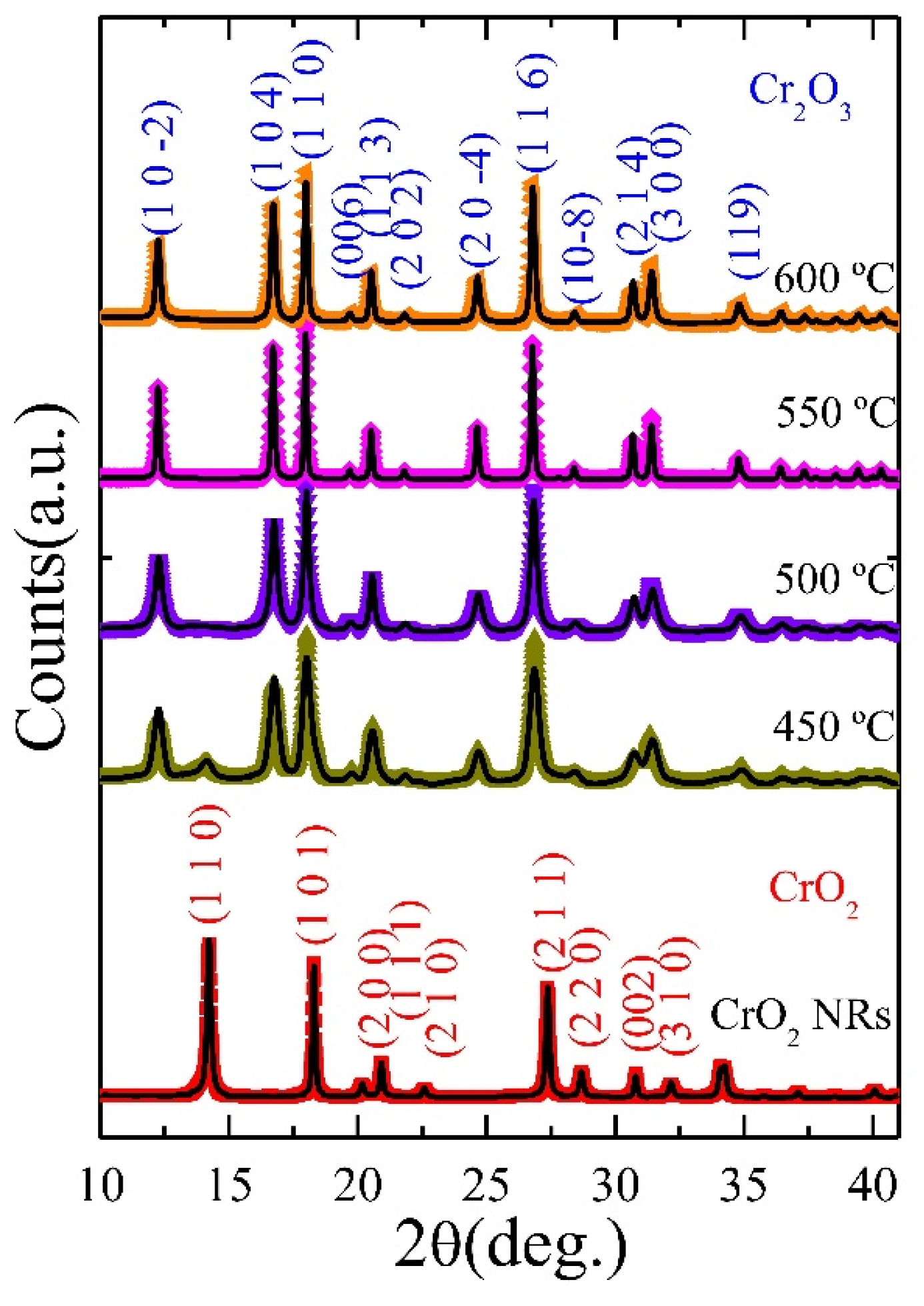
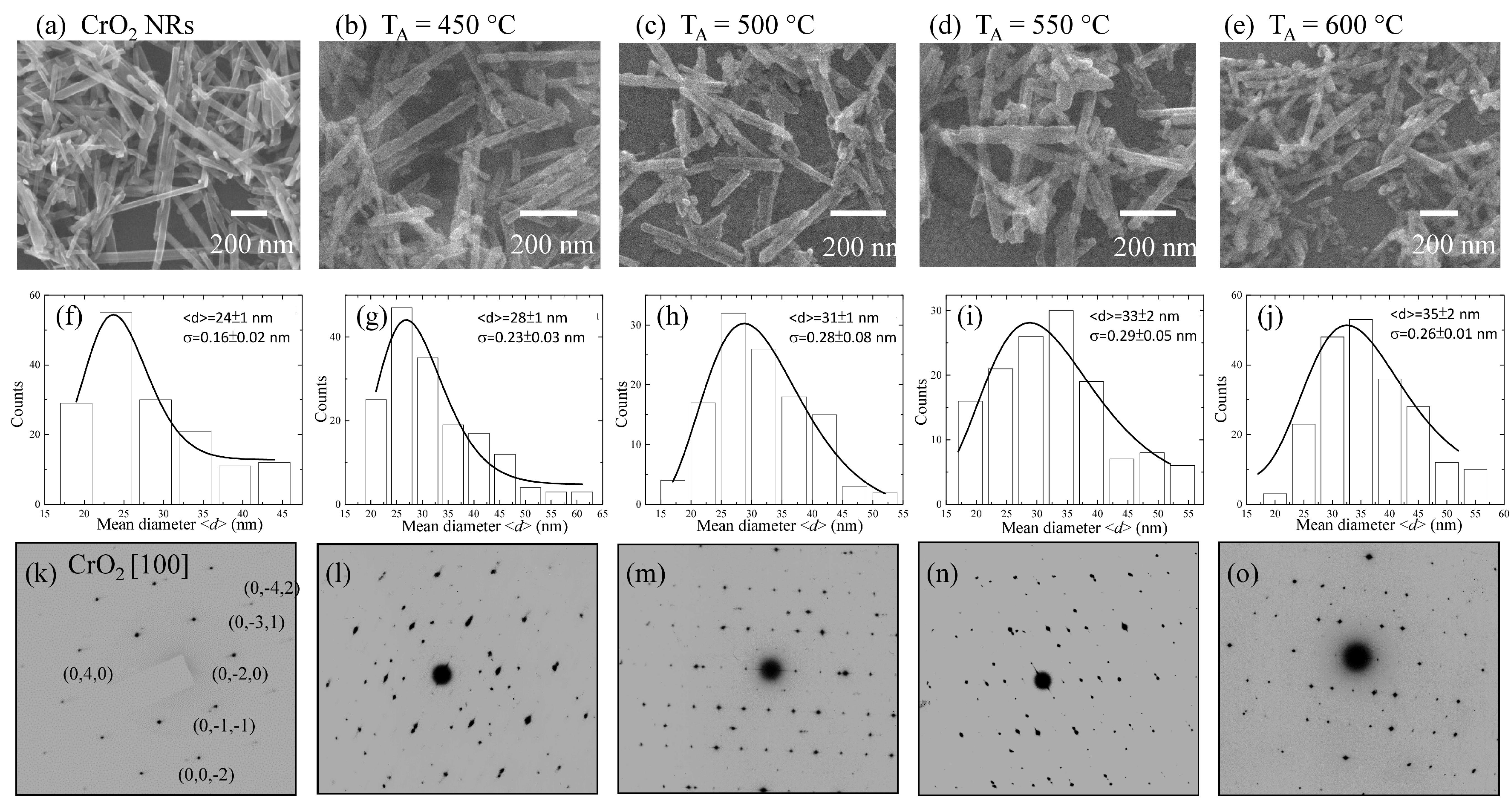

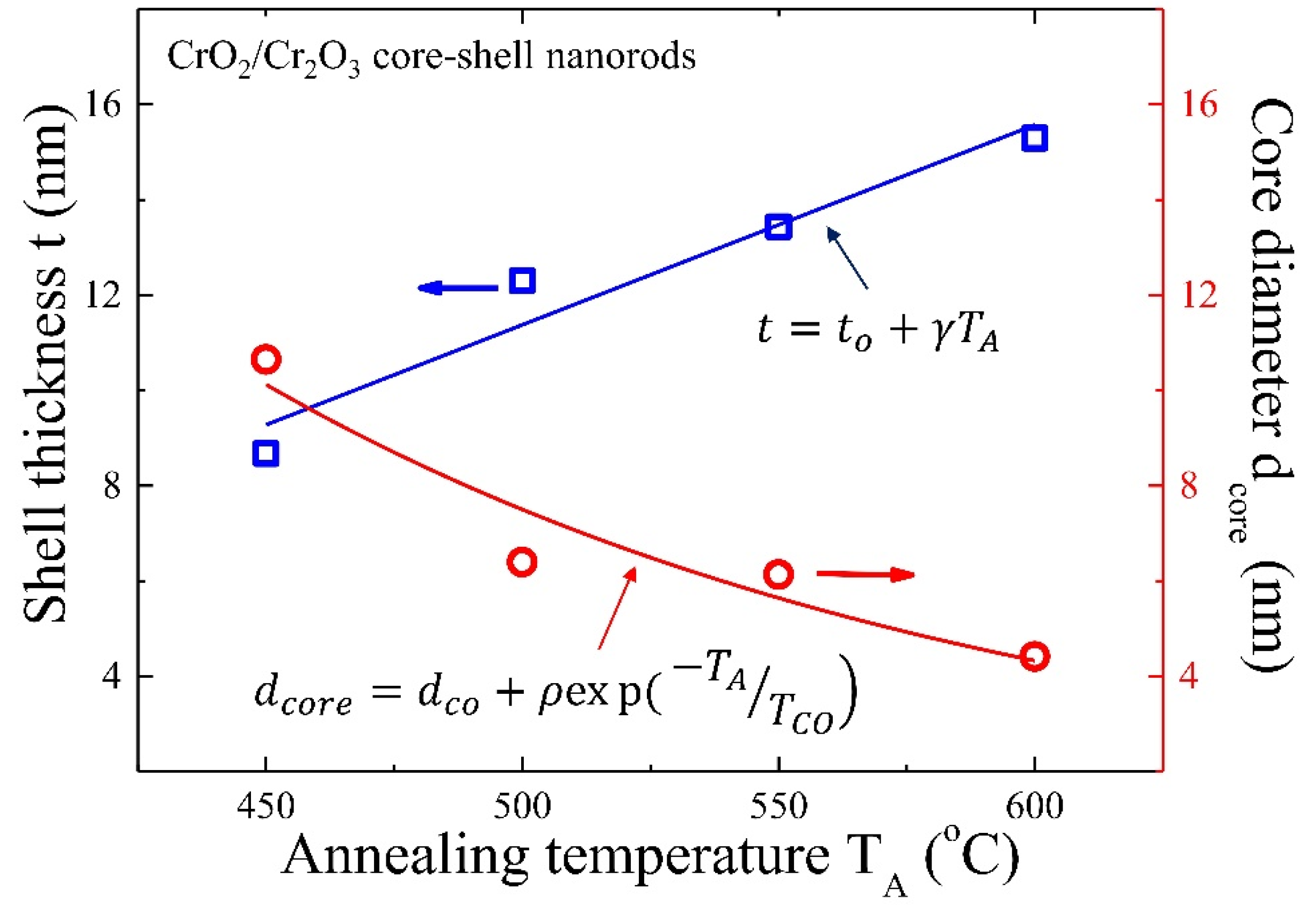
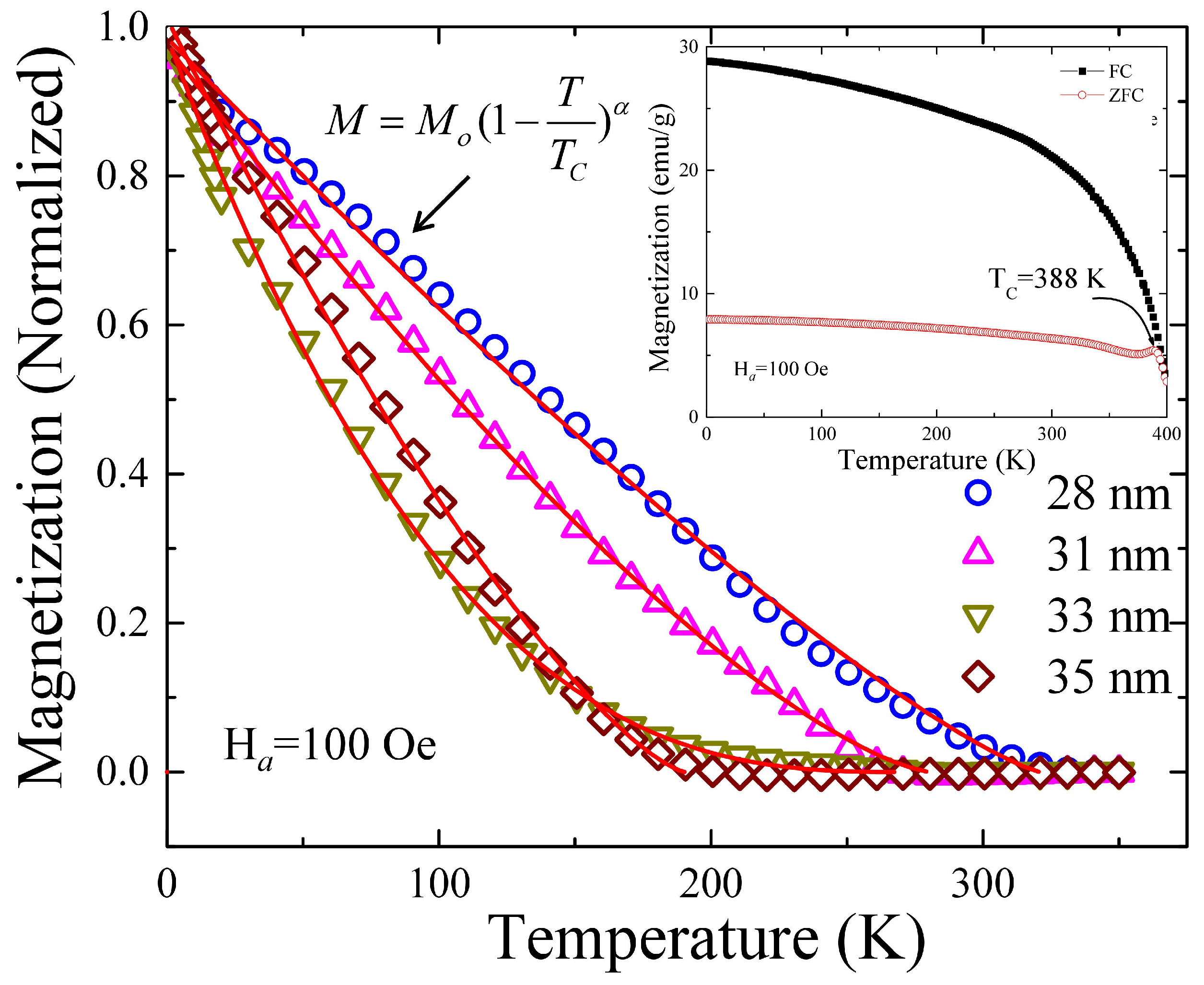

© 2018 by the authors. Licensee MDPI, Basel, Switzerland. This article is an open access article distributed under the terms and conditions of the Creative Commons Attribution (CC BY) license (http://creativecommons.org/licenses/by/4.0/).
Share and Cite
Gandhi, A.C.; Li, T.-Y.; Chan, T.S.; Wu, S.Y. Short-Range Correlated Magnetic Core-Shell CrO2/Cr2O3 Nanorods: Experimental Observations and Theoretical Considerations. Nanomaterials 2018, 8, 312. https://doi.org/10.3390/nano8050312
Gandhi AC, Li T-Y, Chan TS, Wu SY. Short-Range Correlated Magnetic Core-Shell CrO2/Cr2O3 Nanorods: Experimental Observations and Theoretical Considerations. Nanomaterials. 2018; 8(5):312. https://doi.org/10.3390/nano8050312
Chicago/Turabian StyleGandhi, Ashish C., Tai-Yue Li, Ting Shan Chan, and Sheng Yun Wu. 2018. "Short-Range Correlated Magnetic Core-Shell CrO2/Cr2O3 Nanorods: Experimental Observations and Theoretical Considerations" Nanomaterials 8, no. 5: 312. https://doi.org/10.3390/nano8050312






